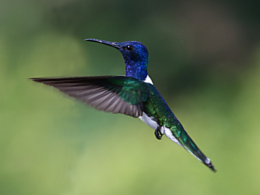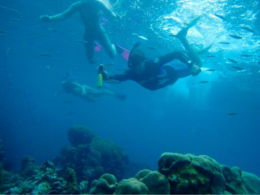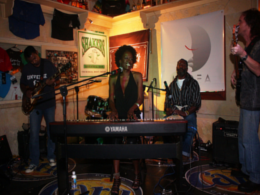Trinidad and Tobago officially the Republic of Trinidad and Tobago, is a twin island country situated off the northern edge of South America mainland, lying 11 kilometres (6.8 miles) just off the coast of northeastern Venezuela and 130 kilometres (81 miles) south of Grenada. Bordering the Caribbean to the north, it shares maritime boundaries with other nations including Barbados to the northeast, Grenada to the northwest, Guyana to the southeast, and Venezuela to the south and west. Trinidad and Tobago lies outside of the hurricane belt.
Trinidad and Tobago is the third richest country by GDP (PPP) per capita in the Americas after the United States and Canada. Furthermore, it is recognised as a high income economy by the World Bank. Unlike most of the English-speaking Caribbean, the country's economy is primarily industrial, with an emphasis on petroleum and petrochemicals. The country's wealth is attributed to its large reserves and exploitation of oil and natural gas. Trinidad and Tobago is the leading Caribbean producer of oil and gas.
Trinidad and Tobago is a dual-island Caribbean nation near Venezuela, with distinctive Creole traditions and cuisines. Trinidad’s capital, Port of Spain, hosts a boisterous carnival featuring calypso and soca music. Numerous bird species inhabit sanctuaries such as the Asa Wright Nature Centre. The smaller island of Tobago is known for its beaches and the Tobago Main Ridge Forest Reserve, which shelters hummingbirds.
Population: 1.341 million(2013)
Area: 1,981 mi²
Capital: Port of Spain
Languages: English
Currency
The currency of Trinidad & Tobago is the T&T dollar. Coins come in denominations of TT$1 and 50, 25, 10, 5 and 1 cents; and banknotes in TT$1, 5, 10, 20 and 100.
Major credit cards (Master Card, Visa, and American Express) are accepted almost everywhere, but don't expect to use cards at small shops, stalls and bars, etc. The US dollar is accepted in most establishments, but it is wiser and cheaper to use local TT currency. It certainly does not make financial sense to change from your local currency to US dollars and then have these converted to TT dollars at typical rates of less than TT$6=US$1.
Climate
The climate is tropical. There are two seasons annually: the dry season for the first five months of the year, and the rainy season in the remaining seven of the year. Winds are predominantly from the northeast and are dominated by the northeast trade winds. Unlike most of the other Caribbean islands, both Trinidad and Tobago have frequently escaped the wrath of major devastating hurricanes, including Hurricane Ivan, the most powerful storm to have passed close to the islands in recent history, in September 2004. In the Northern Range, the climate is often different in contrast to the sweltering heat of the plains below. With constant cloud and mist cover, and heavy rains in the mountains, the temperature is much cooler.
Record temperatures for Trinidad and Tobago are 39 °C (102 °F) for the high in Port of Spain, and a low of 12 °C (54 °F).
Safety
Trinidad and Tobago has one of the highest murder rates in the world. Generally, it is best to travel with the sun. When it sets, make sure you are in a safe place with people you trust. This is more important in Trinidad than in Tobago. In Port of Spain, areas east of Charlotte Street become increasingly unsafe.
Health
The islands do have mosquitoes and isolated cases of dengue fever have been reported. The tap water is generally safe to drink, though many visitors prefer bottled water because the public water often has a strong chlorine taste. Use your best judgement if in an area where homes collect rain water from the roof, but very few problems are reported.
The adult HIV/AIDS prevalence at 3.0{30b3c1a05441a6ec696a3ef2bf35d9a34dfa377050be22c8a6500787eb0a1c7f} or 1 in 33 adults, which is 5 times higher than the USA. The best advice is to use caution and use protection if engaging in sexual activity. Condoms are available from pharmacies to help prevent the spread of AIDS and other STD's.
If you need prescription medication, it is best to bring enough with you for the duration of your trip. There is no guarantee that what you need will be available. American OTC drugs are often available in many pharmacies, however, don't expect everything to be available. They may also be under different names whether American or European market names.
Public Healthcare is free to everyone in Trinidad and Tobago and is paid for by the Government and taxpayers. Healthcare services are offered on a walk-in basis. There are a few major hospitals throughout the country as well as smaller health centers and clinics located regionally.
Transportation
Public transport is provided by a government-run bus service (known as the Public Transport Service Corporation, or PTSC), privately owned mini-buses (locally known as maxi-taxis), as well as privately owned cars. Maxi-taxis and some cars carry passengers along fixed routes for a fixed fare, although cars are slightly more expensive for similar routes carried by maxi-taxis because of their much smaller passenger capacities. Travellers can also negotiate with car taxi drivers to go off-route for short distances for an additional charge if one's destination is not exactly on the car taxi's route. Car taxis are not allowed to utilise the Priority Bus Route, however, and as such maxi-taxis and buses are preferable for speedily entering and exiting the cities (especially Port of Spain) during rush hour (7am–9am and 4pm–6pm).
popular car rentals: Economy, Kayak, Avis, Enterprise and Sixt
Top Beaches
Pigeon point
Pigeon Point is also known as Pigeon Point Heritage Park and is often considered Tobago’s most beautiful beach and is home to the famous thatch-roofed jetty which has become an internationally recognised signature of Tobago. The resort includes a long stretch of white sand beach with warm aquamarine waters. There are excellent beach facilities such as bathrooms, showers and beach-chair rentals as well as bars and a restaurant. Tourist amenities include souvenir and water-sports shops.
Englishman’s Bay
Englishman's Bay is a secluded beach on the leeward coast of Tobago, between Castara and Parlatuvier. Although the bay does not draw the large numbers of beachgoers that Tobago's western beaches do, it is considered of the islands most beautiful. The beach itself is a classic crescent shape, capped by two heavily forested headlands descending from Tobago's Main Ridge. The sand starts immediately after the forest ends and is of a shallow to medium gradient and somewhat coarse grain. The beach itself does not change size drastically at high or low tides, due to the gradient. The waters are calm year-round, with swells growing slightly in size toward the winter months, and boast magnificent snorkeling and swimming.
Parlatuvier Bay
Parlatuvier Bay, located at the North Western end of Tobago, is another gem on the island. Its value, perhaps, is in the beach’s golden sand but the overall landscape is what really makes the beach a beauty to behold. About 50 minutes’ drive from Scarborough, Parlatuvier Bay is a tranquil beach about 500 metres long. It is partly sheltered, so the water is quite calm with small lapping waves. However, the waves can be strong at times. Entering Parlatuvier Bay, the river meets the sea and visitors usually express pleasure bathing at the river mouth. Fishing is also part of the village livelihood so small fishing boats line the shore. The beach also has a jetty about 200 meters long. The beach is surrounded by the village with rugged rocks closing it in from the sea. The natural enclosure makes the beach ideal for swimming and snorkelling, but caution must be taken since the beach is tucked away and there is no lifeguard here. The water gets deep quickly and there is excellent jumping and diving from the jetty.
The blue-green waters of this picturesque destination are inviting for swimming, snorkelling and scuba diving.
Stonehaven bay
Located off the Grafton Road between Mt. Irvine and Black Rock in south west Tobago, Stonehaven Bay is great for snorkeling towards its northern end closer to the Grafton Beach Resort. If you are interested in turtle watching, then you are in luck as the Bay is one of the few destinations in Tobago where the leatherback turtle nests between the months of March and June. The attractive golden sands combined with the cool breezes coming off of the bay and the natural beauty of the location makes for the perfect setting for a intimate destination wedding.
Stonehaven Bay is a picturesque beach destination that comprised of soft, light brown, medium grain sand that is ideal for destination weddings, leisurely romantic walks, sunbathing, snorkeling, kayaking and surfing.
Maracas Bay
On any given Sunday, Maracas Bay is never empty. Its beauty – off white sand, palm trees and blue-green waters – attracts beach lovers to this crescent coast line which stretches for 2 km. he expanse of beach is enough to accommodate the sunbather who likes her space or the nature lover who welcomes the sea blast as they set up camp. Maracas Bay has also garnered the reputation for being the lunch spot with an idyllic view. Known as the home of bake and shark, this destination is host to a variety of vendors who prepare the tasty offering. The most popular beach in Trinidad, Maracas Bay is home to great tans, exciting surf and the wildly popular local street food known as bake and shark.
Las Cuevas Bay
Las Cuevas is the first and only Blue Flag-certified beach in the Southern English-speaking Caribbean. The certification means that the beach meets international standards of cleanliness, safety and environmental awareness and sustainability. In contrast to Maracas Bay which is some 10 to 15 minutes away, the waters here are less robust and attract sea bathers who appreciate the calmer breakers of 80 centimeters. It is also more secluded and less crowded than Maracas Bay. It’s a sheltered horseshoe bay which provides protection from the wind, making it an ideal spot for swimmers. Las Cuevas Bay is home to the only Blue Flag-certified beach in Trinidad and Tobago. Great for swimming and sunbathing, it is the longest (22km) strip of sand and the second most popular beach on the North Coast.
Store Bay
One of the busiest and most popular of Tobago’s beaches, Store Bay is known for many things: the two-minute walking distance from the ANR Robinson International Airport; Miss Jean’s curry crab and dumpling; the ladies selling local snacks like red mango, fudge and benet sticks; sale of local arts and crafts; the departure spot for boat tours to Buccoo Reef. If you want to experiment with snorkelling, here is a good place to start as fish sometimes come close to shore. If relaxation is your cup of tea, then Store Bay is excellent for that as well as there are numerous locals eagerly ready to rent you beach chairs and umbrellas for a breezy nap. Located on Tobago’s South Western coast, the sunset at Store Bay is a spectacular sight.
Activities




















